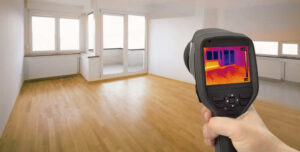6 Ways to Locate Hidden Water Leaks in Your Home
6 Ways to Locate Hidden Water Leaks in Your Home
Blog Article
We've stumbled upon this article about Locating water leaks down the page on the net and concluded it made perfect sense to talk about it with you on this site.

Early detection of leaking water lines can minimize a possible catastrophe. Apart from conserving you cash, it will reduce the stress as well as aggravation. The moment you find a leakage, calling your plumber for fixings is the best option. Nevertheless, some small water leaks may not show up. If you can not spot it with your nude eyes, right here are some hacks that aid.
1. Take A Look At the Water Meter
Every residence has a water meter. Examining it is a surefire way that assists you discover leaks. For beginners, turn off all the water resources. Guarantee no person will purge, use the tap, shower, run the cleaning equipment or dish washer. From there, go to the meter as well as watch if it will change. Given that no person is using it, there should be no movements. If it relocates, that suggests a fast-moving leak. If you detect no changes, wait an hour or 2 and inspect back once more. This suggests you may have a sluggish leak that could even be underground.
2. Check Water Intake
If you detect unexpected modifications, despite your intake being the exact same, it suggests that you have leakages in your plumbing system. An unexpected spike in your bill shows a fast-moving leak.
On the other hand, a steady rise on a monthly basis, even with the very same routines, reveals you have a sluggish leak that's also slowly intensifying. Call a plumber to extensively inspect your property, particularly if you feel a warm location on your floor with piping underneath.
3. Do a Food Coloring Examination
When it involves water intake, 30% comes from bathrooms. Examination to see if they are running effectively. Decline flecks of food shade in the tank and also wait 10 mins. If the shade somehow infiltrates your bowl during that time without flushing, there's a leak between the storage tank as well as dish.
4. Asses Outside Lines
Do not neglect to examine your outside water lines as well. Must water seep out of the connection, you have a loosened rubber gasket. One little leakage can squander heaps of water as well as surge your water expense.
5. Evaluate and Analyze the Situation
Home owners need to make it a practice to inspect under the sink counters as well as even inside closets for any bad odor or mold and mildew growth. These 2 warnings suggest a leak so timely interest is required. Doing routine examinations, also bi-annually, can save you from a significant issue.
Examine for stainings and weakening as many devices as well as pipelines have a life span. If you suspect dripping water lines in your plumbing system, do not wait for it to escalate.
Early discovery of leaking water lines can minimize a potential calamity. Some small water leakages might not be noticeable. Inspecting it is a guaranteed method that aids you uncover leakages. One little leak can waste loads of water and also spike your water bill.
If you suspect dripping water lines in your plumbing system, don't wait for it to rise.
WARNING SIGNS OF WATER LEAKAGE BEHIND THE WALL
PERSISTENT MUSTY ODORS
As water slowly drips from a leaky pipe inside the wall, flooring and sheetrock stay damp and develop an odor similar to wet cardboard. It generates a musty smell that can help you find hidden leaks.
MOLD IN UNUSUAL AREAS
Mold usually grows in wet areas like kitchens, baths and laundry rooms. If you spot the stuff on walls or baseboards in other rooms of the house, it’s a good indicator of undetected water leaks.
STAINS THAT GROW
When mold thrives around a leaky pipe, it sometimes takes hold on the inside surface of the affected wall. A growing stain on otherwise clean sheetrock is often your sign of a hidden plumbing problem.
PEELING OR BUBBLING WALLPAPER / PAINT
This clue is easy to miss in rooms that don’t get much use. When you see wallpaper separating along seams or paint bubbling or flaking off the wall, blame sheetrock that stays wet because of an undetected leak.
BUCKLED CEILINGS AND STAINED FLOORS
If ceilings or floors in bathrooms, kitchens or laundry areas develop structural problems, don’t rule out constant damp inside the walls. Wet sheetrock can affect adjacent framing, flooring and ceilings.
https://www.servicemasterbyzaba.com/blog/how-to-detect-water-leakage-in-walls/

Do you really like reading up on Leaking water lines? Make feedback below. We would be pleased to hear your opinions about this blog entry. We hope to see you back again soon. Are you aware of somebody who is inquisitive about the subject? Why not promote it. Thanks for your time. Please stop by our site back soon.
Report this page